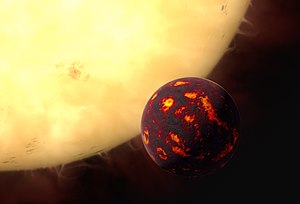55 Cancri e
| Exoplanet | List of exoplanets | |
|---|---|---|
 |
||
| Parent star | ||
| Star | 55 Cancri A | |
| Constellation | Cancer | |
| Right ascension | (α) | 08h 52m 35.8s |
| Declination | (δ) | +28° 19′ 51″ |
| Apparent magnitude | (mV) | 5.95 |
| Distance | 40.3 ± 0.4 ly (12.3 ± 0.1 pc) |
|
| Spectral type | G8V | |
| Mass | (m) | 0.95 ± 0.10 M☉ |
| Radius | (r) | 1.152 ± 0.035 R☉ |
| Temperature | (T) | 5373 ± 9.7 K |
| Metallicity | [Fe/H] | 0.29 |
| Age | 7.4–8.7 Gyr | |
| Orbital elements | ||
| Semi-major axis | (a) | 0.01560 ± 0.00011AU (2.333 Gm) |
| 1.27 mas | ||
| Periastron | (q) | 0.0129 AU (1.94 Gm) |
| Apastron | (Q) | 0.0183 AU (2.73 Gm) |
| Eccentricity | (e) | 0.17 ± 0.04 |
| Orbital period | (P) | 0.7365449 (± 0.000005)d |
| (17.677 h) | ||
| Inclination | (i) | 83.4 ± 1.7° |
| Argument of periastron |
(ω) | 181 ± 2° |
| Time of periastron | (T0) | 2,449,999.83643 ± 0.0001JD |
| Semi-amplitude | (K) | 6.2 ± 0.2m/s |
| Physical characteristics | ||
| Mass | (m) | 8.63 ± 0.35M⊕ |
| Radius | (r) | 2.00 ± 0.14R⊕ |
| Stellar flux | (F⊙) | 2590 ⊕ |
| Density | (ρ) | 5.9+1.5 −1.1g cm−3 |
| Discovery information | ||
| Discovery date | August 30, 2004 | |
| Discoverer(s) | McArthur et al. | |
| Discovery method | Radial velocity | |
| Other detection methods | Transit, Orbital phase light variations |
|
| Discovery site | Texas, United States | |
| Discovery status | Published | |
| Other designations | ||
|
Janssen, 55 Cancri Ae, Rho1 Cancri e, HD 75732 e
|
||
| Database references | ||
| Extrasolar Planets Encyclopaedia |
data | |
| SIMBAD | data | |
| Exoplanet Archive | data | |
| Open Exoplanet Catalogue | data | |
55 Cancri e (abbreviated 55 Cnc e, also named Janssen), is an exoplanet in the orbit of its Sun-like host star 55 Cancri A. The mass of the exoplanet is about 8.63 Earth masses and its diameter is about twice that of the Earth, thus classifying it as the first super-Earth discovered around a main sequence star, predating Gliese 876 d by a year. It takes less than 18 hours to complete an orbit and is the innermost known planet in its planetary system. 55 Cancri e was discovered on 30 August 2004. However, until the 2010 observations and recalculations, this planet had been thought to take about 2.8 days to orbit the star. In October 2012, it was announced that 55 Cancri e could be a carbon planet.
In July 2014 the International Astronomical Union launched a process for giving proper names to certain exoplanets and their host stars. The process involved public nomination and voting for the new names. In December 2015, the IAU announced the winning name was Janssen for this planet. The winning name was submitted by the Royal Netherlands Association for Meteorology and Astronomy of the Netherlands. It honors the spectacle maker and telescope pioneer Zacharias Janssen.
In February 2016, it was announced that NASA's Hubble Space Telescope had detected hydrogen and helium (and suggestions of hydrogen cyanide), but no water vapor, in the atmosphere of 55 Cancri e, the first time the atmosphere of a super-earth exoplanet was analyzed successfully.
...
Wikipedia
